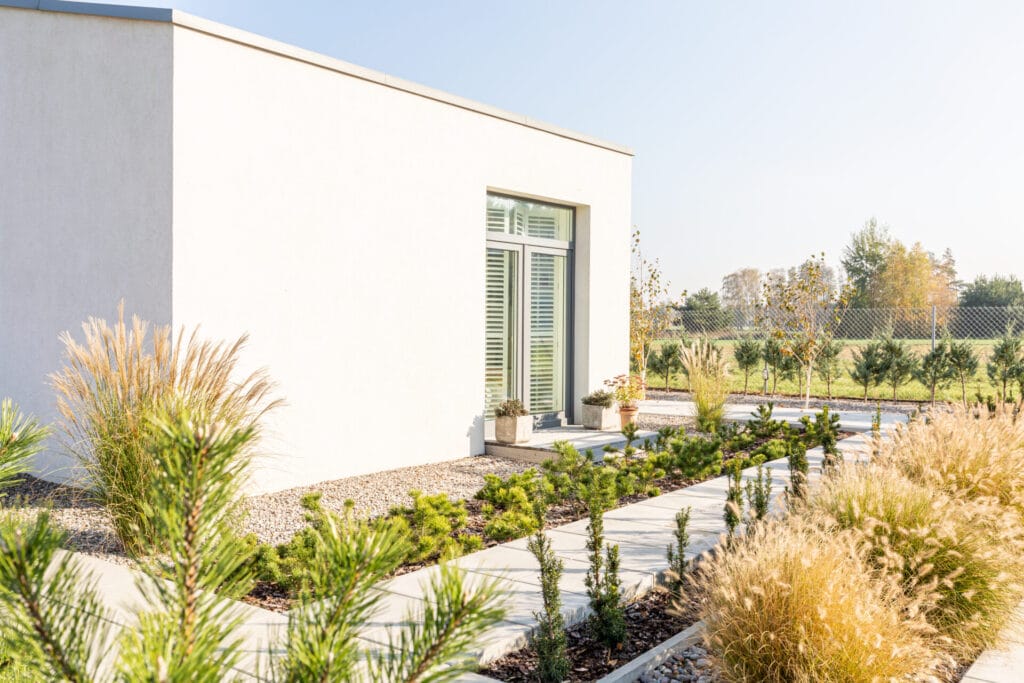
BY DANIELA GIRALDO – APRIL 17, 2024

In the world of landscaping, xeriscaping has emerged as a beacon of sustainability and beauty. Originating from the Greek word “xeros,” meaning dry, xeriscaping focuses on creating lush outdoor spaces while minimizing water usage. As environmental consciousness grows, so does the popularity of xeriscaping. Let’s explore ten stunning xeriscaped landscaping designs that not only conserve water but also captivate with their beauty and functionality.
Picture yourself in a serene desert oasis, surrounded by cacti, succulents, and vibrant stones. This xeriscaping design embraces the natural beauty of arid landscapes while providing a tranquil retreat. Drought-tolerant plants like agave and yucca thrive in this environment, accented by strategically placed boulders and gravel pathways. A focal point, such as a cascading water feature powered by a solar pump, adds a touch of luxury without compromising sustainability.
Transport yourself to the sun-drenched coasts of the Mediterranean with this xeriscaping design inspired by the region’s flora and architecture. Olive trees, lavender bushes, and rosemary hedges create a sensory experience, enticing visitors with their fragrant blooms and culinary potential. Terra cotta pots, rustic stone walls, and tiled pathways evoke the charm of a Mediterranean villa, while efficient drip irrigation systems ensure optimal water distribution.
Embrace the clean lines and understated elegance of modern minimalism with this xeriscaping design. Utilizing a limited palette of plants and materials, such as ornamental grasses, succulents, and sleek concrete pavers, this landscape exudes sophistication and simplicity. A geometric layout, punctuated by sculptural elements and strategic lighting, creates visual interest while requiring minimal maintenance. Rainwater harvesting systems and permeable surfaces further enhance the sustainability of this design.
Capture the essence of coastal living with a xeriscaped landscape that celebrates the beauty of sandy shores and salt-tolerant flora. Sea oats, beach grasses, and dune sunflowers thrive in sandy soil, creating a natural buffer against erosion and salt spray. Driftwood accents, shell pathways, and native dune plants evoke the tranquility of a seaside retreat, while efficient irrigation techniques conserve water and support coastal ecosystems.
Find inner peace and tranquility in a xeriscaped Zen garden that harmonizes with nature’s rhythms. Inspired by traditional Japanese gardens, this design emphasizes simplicity, balance, and mindfulness. Gravel raked into patterns reminiscent of rippling water, carefully pruned bonsai trees, and moss-covered rocks invite contemplation and meditation. Bamboo fences, wooden bridges, and lanterns add to the ambiance, while water-efficient drip irrigation systems maintain the garden’s pristine beauty.
Transform a barren rooftop into a verdant oasis with a xeriscaping design tailored for urban environments. Drought-tolerant grasses, sedums, and rooftop gardens thrive in the harsh conditions of city living, providing much-needed greenery and habitat for pollinators. Raised planters, modular seating, and trellises maximize space efficiency while creating areas for relaxation and socializing. Smart irrigation systems and green roof technology reduce heat absorption and stormwater runoff, contributing to urban sustainability efforts.
Elevate xeriscaping to new heights with a design inspired by the rugged beauty of high desert landscapes. Native shrubs like sagebrush, rabbitbrush, and penstemon mingle with colorful wildflowers and hardy succulents, creating a tapestry of texture and color. Rock outcroppings, dry creek beds, and salvaged materials reflect the resilience and adaptability required to thrive in extreme environments. Drip irrigation, mulching, and soil amendments ensure the health and vitality of this unique ecosystem.
Capture the whimsy and romance of a cottage garden with a xeriscaping design that blends vintage charm with modern sustainability. Old-fashioned favorites like lavender, roses, and delphiniums mingle with drought-tolerant perennials and native wildflowers, creating a profusion of color and fragrance. Winding pathways, arched arbors, and weathered stone walls evoke the nostalgia of bygone eras while providing habitat for beneficial insects and wildlife. Rain barrels, compost bins, and organic mulches contribute to the garden’s eco-friendly ethos.
Escape to a tropical paradise without leaving your backyard with a xeriscaping design inspired by lush rainforests and island retreats. Palms, ferns, and bromeliads create a verdant canopy overhead, while tropical flowers like orchids, hibiscus, and bird of paradise add bursts of color and exotic flair. Water features, such as cascading fountains and lagoon-style pools, evoke the soothing sounds of nature, while efficient irrigation systems and rainwater harvesting techniques ensure sustainability in even the driest climates.
Celebrate the beauty and resilience of native plants with a xeriscaping design that honors the natural heritage of the region. Indigenous grasses, wildflowers, and shrubs create a biodiverse landscape that supports local ecosystems and wildlife. Natural stone accents, meandering pathways, and native grass lawns blend seamlessly with the surrounding environment, fostering a sense of belonging and stewardship. Rain gardens, bioswales, and permeable paving promote water infiltration and recharge, reducing the impact of urban development on watersheds and water quality.
Xeriscaping offers a harmonious blend of sustainability and beauty, allowing homeowners to create stunning landscapes that thrive in harmony with nature. Whether inspired by desert vistas, coastal retreats, or tropical paradises, these ten xeriscaped landscaping designs demonstrate the endless possibilities for creating outdoor spaces that are as eco-friendly as they are breathtaking. By embracing xeriscaping principles, we can conserve water, support biodiversity, and enhance the beauty of our surroundings for generations to come.
Share this post:
Check other topics that may help you get more insights for your project:





